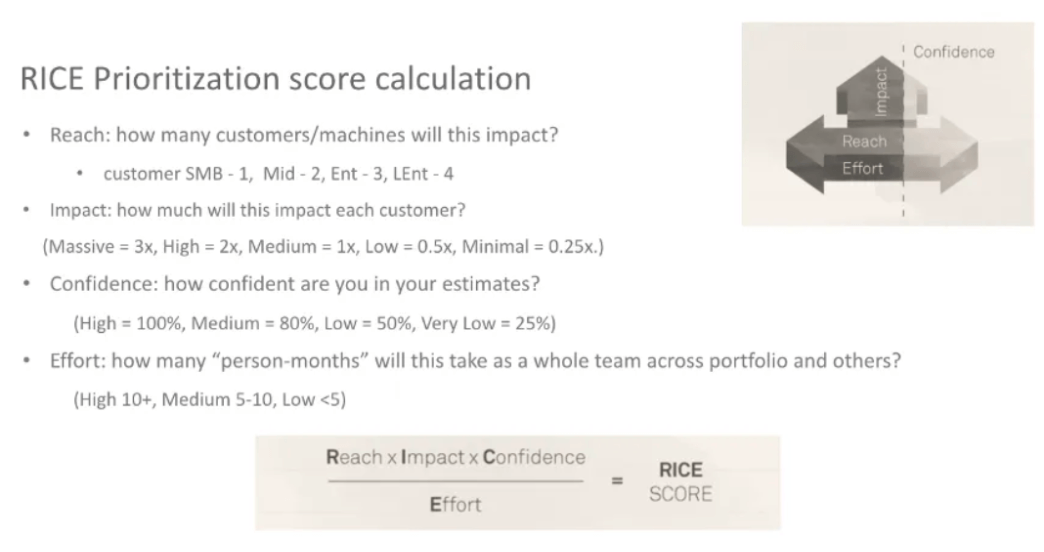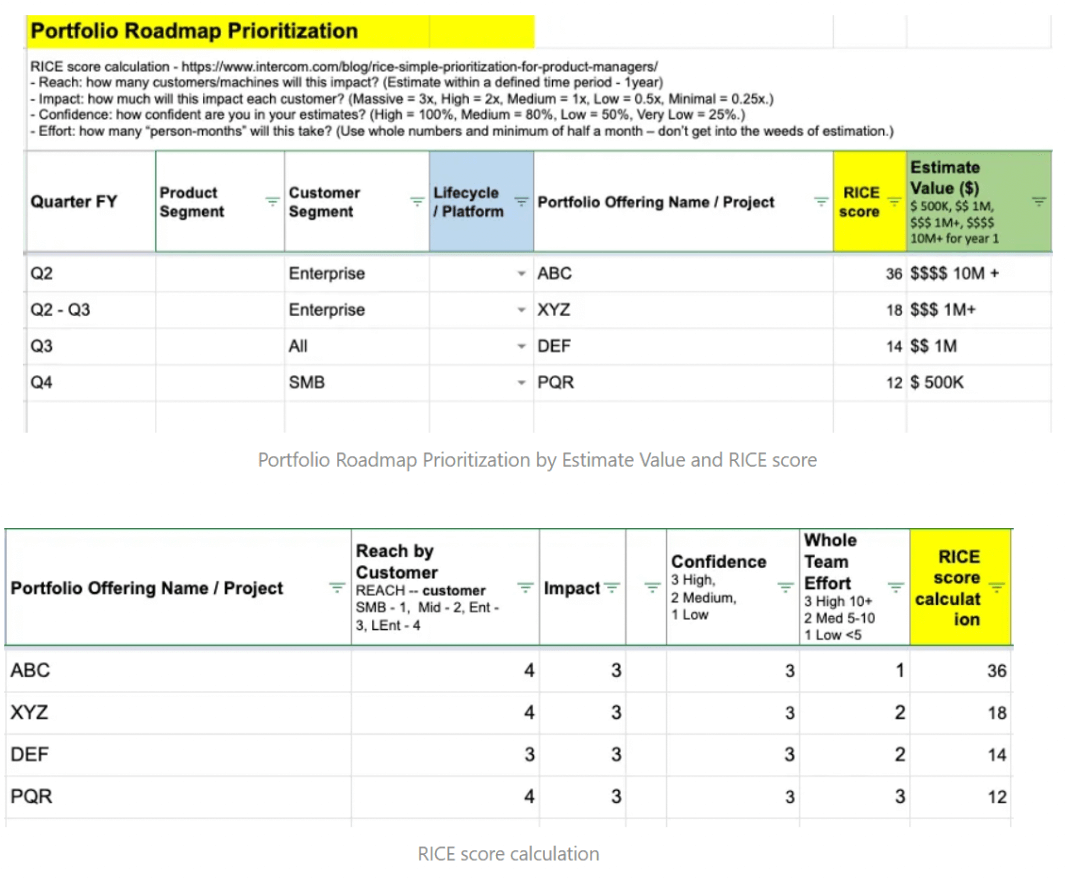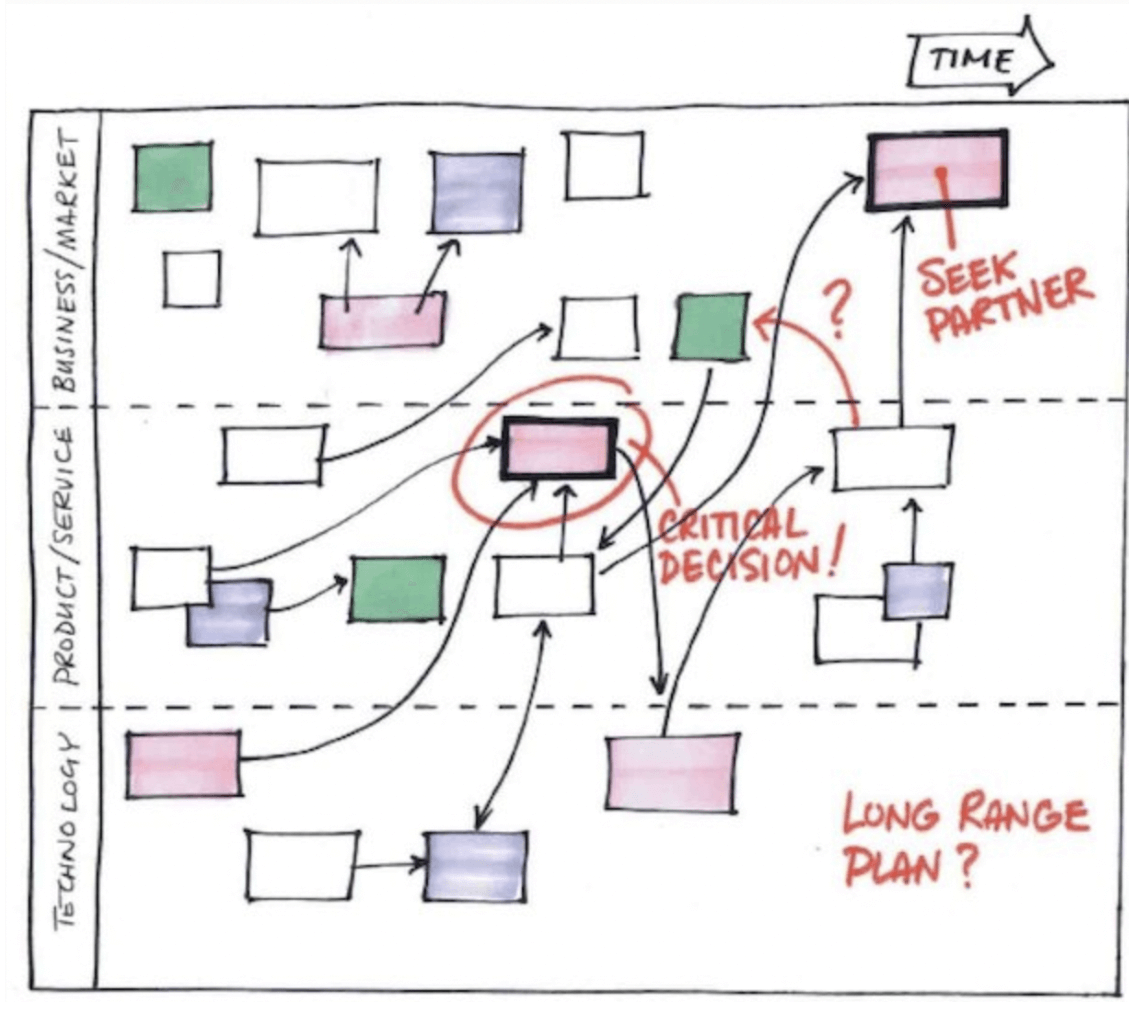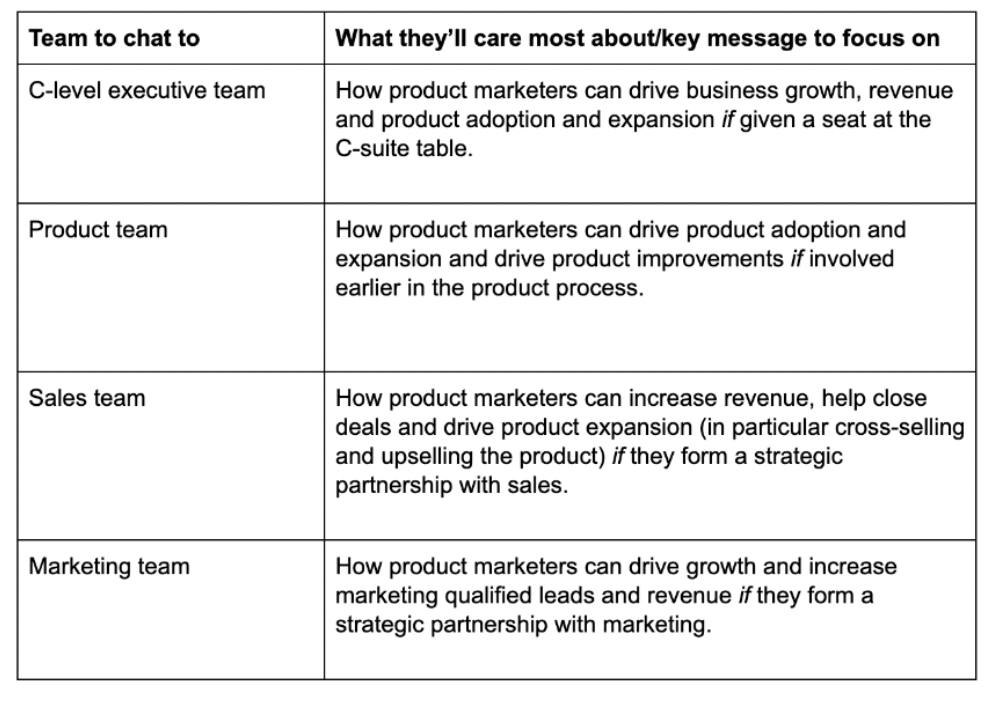It’s official: the legion of product marketers is growing - fast, many of which are chomping at the bit to reach the upper echelon of the product marketing pyramid.
In fact, the State of Product Marketing Report 2022 revealed 63.8% of product marketers want to take the next step in their careers and progress into a more senior position.

Psst. Complete the State of Product Marketing Report 2023 survey and help us establish if this trend’s changed.
With competition rife, it’s more important than ever to ensure you’re equipped with the relevant product marketing skills to make your voice heard and stand out in the crowd.
In this article, we’ll explore a select trio of skills you ought to finetune as part of your personal and professional development, including:
- Product roadmapping
- Personas
- Professional relationship management
Product roadmapping
How to build a product roadmap
You may be thinking, “how do I actually build a product roadmap?”
There are different ways you can go about building a roadmap but here are the main principles you should adhere to:
- Start with an Excel, Google Sheets or a roadmapping tool.
- Before you share your roadmap with your stakeholders, tell them you’re creating it and ask for their input. The aim is for the document to feel like a collaboration and to get everyone pulling in the same direction.
- It needs to be time specific. Divide your roadmap up into blocks of time. If you’ve been given a timeframe from leadership then your road map should lead up to that deadline.
- Think about the different types of tasks you’ll need to accomplish to move forward with your strategy and assign a section on your sheet for each one. We’d always recommend including research as a task, as great product marketing starts with solid research.
- You should account for cross-functional collaboration within your roadmaps. Think about how often you’ll need to speak to other teams and what help you’ll need to tactically implement your plan.
- You should also assess threats within your roadmap. Make a note if you might not deliver something on time.
- Make it as detailed as it needs to be. Throughout your career, you’ll work with some very simple road maps and some very detailed ones.
For example, a positioning and messaging strategy roadmap for the next five years is bound to be a long and detailed document, whereas a new upsell or cross-sell strategy roadmap will probably be on the simpler side.
- Include the metrics that you plan to measure to check you’re on track with your plan.
- There’s no rule against getting creative and making them visually interesting - just make sure the focus is always on accuracy and making them very easy to digest at a glance.
- Remember to stay flexible with your roadmap and accept that unexpected roadblocks and competing priorities may appear further down the line.
- Lastly, you shouldn’t plan for 100% of the time you have available. Always leave time in your roadmap for unexpected and ad hoc tasks.
When it comes to assessing which projects you should treat as a priority, Div Manickam, Product Marketing expert, mentor and author advocates for the RICE method. RICE stands for Reach, Impact, Confidence and Effort and can serve as the answer to get clarity on each of your projects.
The RICE score calculation works like this:

And here’s an example of RICE in action within a spreadsheet:

Here’s an example of a very simple roadmap broken down by technology, product and business market. Each note on this roadmap would signify a key event and you can see how all the different tasks overlap for each area:

While you may be equipped with the knowledge to complete your roadmapping, we’ve whipped together a super handy internal roadmapping template to help you effectively plan your campaigns with precision.
Positioning yourself to deliver strategy
The first thing you need to do to position yourself to deliver strategy is implement effective roadmapping techniques.
Once you’ve tried the method, and you know how to go about creating a strategy, you can turn a small win into a huge win. Showing what you’re capable of on a small, low-risk scale will increase the chance that leadership will give you the responsibility for bigger positioning, messaging and Go-to-Market strategies for the organization.
Once you get to the stage where you’re working on positioning and messaging strategy roadmapping you need to make sure you own the story of the product.
“Product marketers should own the product story. It’s their job to be expert storytellers and to create effective positioning, a compelling vision for the product, value propositions, etc.”
Marcus Andrews, Director of Product Marketing at Pendo.io | Narrative Designer.
It’s no secret that capturing the attention of your target audience, particularly in the SaaS B2B world is a monumental task.
Creating and owning a story that actually stands out and positions your company powerfully, is incredibly hard especially when most tech companies are competing in overcrowded categories, to begin with. However, you must do so if you want to own a strategy within your company.
Another thing you need to do to realize your potential as a strategist is to identify non-product marketing tasks and give them to the relevant teams. We’ve heard time and time again that product marketers have to work with people who don’t fully understand what they do.
“Ask anyone what sales reps do, and they’ll tell you they sell stuff. Ask anyone what accountants do and they’ll tell you they’re responsible for financial records. Ask anyone what product marketers do, and… you’ll get wildly different answers at best, blank expressions at worst.”
Richard King and Bryony Pearce, Product Marketing Misunderstood
This misunderstanding means that PMMs are often asked to do things that don’t actually fall within their remit, create blog posts and write sales scripts for example.
One powerful way to free yourself from this is to define as early as possible what you’re responsible for and what you aren’t responsible for. This needs to be written down, circulated and easily accessible to the rest of the organization.
Learning how to tailor your approach and language for each stakeholder will go a long way in helping you position yourself as the voice of strategy. When you hold meetings with each team, tweak your wording so you focus on what that team cares about the most.
As a product marketer, you should show your stakeholders that you’re there to help them, as well as elevate your own role. Here’s an example of how to do this for your main stakeholders:

Following these tips will serve you well when it comes to gaining positive attention to the work you do and encourage others to want a great working relationship with the product marketing team.
Personas
Why are personas important?
Next, let’s take a look at why personas are so important not only to you but to other business departments.
Failure to get buy-in from the wider business can be the biggest blocker of persona success, so it’s really important not to scrimp on this education stage, and that you emphasise the importance of this persona work.
If you don’t like shooting blanks, personas should be important to you. The most expensive thing you can do is not tailor your message to your audience, and that’s just not a mistake any product marketer or company can afford to make.
This analogy might help you relay the importance of personas to other internal teams who don’t get the importance already. So here it is…
You don’t speak the same way to your friends as you do to people you’ve just met, and you don’t speak to people you’ve just met the same you do to your business partners, your parents, or your grandparents.
You tailor your message to each and every one of them, and when you’re explaining to people in your surrounding what you do for a job, you don’t explain it the same to your grandmother, your mother, and your friends, so why should business be any different? You need to describe your product in different ways, to different people, and if you don’t know who the people are, you’re not going to be heard.
Personas are also the easiest, shorthand way to understand your customers. If someone new walks into your company and has no clue about your customers or your industry, those one-pager, persona documents give them everything they need to get an amazingly good sense of who they’re talking to.
This applies not just to new product marketers, but new sales reps, product managers, customer success folks, and so on. That kind of information is invaluable for new starters and can really streamline, strengthen, and speed up their onboarding process.
Tying in with that, personas ensure company-wide alignment and understanding of who your customers are, and that’s really important because it means people receive a consistent experience when they go from prospect to customer, which results in an all-round better experience with not just your product, but your brand.
Another important benefit of personas is that they enable you to deeply understand your customers on a personal level, and understand their behaviours, customer needs, and challenges. This means you can:
- Bring out products that are hyper-relevant to those needs,
- Build a rapport from the get-go that helps them feel not just like a number, but a valued and understood person, and
- Helps you keep hold of your customers after they’ve chosen your product, because you go from taking a blanket approach and trying to please all customers with the same messaging, onboarding, features and products, with experiences that speak directly to their needs.
It’s Marketing 101, but that personalization element is fundamental to any success. And tying in with that understanding point, personas enable everyone to develop a greater level of empathy with your audience, because you’re humanizing them, and empathy really does sell.
Another important part of personas is the focus they bring to every stage of the buying funnel. If you try to target all people, with all content, all features, all products, all messaging, and so on, it’s just not going to work.
Products and features should be created for personas, and then those products and features should be marketed to personas.
Knowing your target market on an individual, segmented basis makes it much easier to come up with products and features that’ll actually make a difference to their lives, and when you or your marketing team come to writing content around said product or features, personas bring a ton of clarity not only around what to write but where to market it.
For example, if you’re currently shouting about your product on Instagram but your personas aren’t hanging out there, what’s the point? That’s wasted money and resources that could be far better spent in places your personas do hang out.
And finally, personas empower your salespeople. Being able to visualize each customer makes it easier to create purchase path models and helps salespeople understand how to effectively and positively guide consumers through the purchasing experience.
Personas can help salespeople anticipate objections and barriers to purchase — and you can even use your personas to train your sales force on how to address these situations. This results in a better experience for customers as well as the salespeople charged with improving transaction opportunities and the purchasing experience.
Here’s a template from the PMA membership, to help you plan B2B personas questions, on the house. 👍
Next up, let’s take a look at negative personas.
Negative Personas
In this section, we’re going to be focusing on negative personas: what they are, why they’re important, and when to use them.
Straight-up personas shape the direction of marketing and sales efforts. When companies know who their target audience is, this highlights which segments of the market need the product, and relevant collateral can be shaped to speak the language of the target audience and enhance performance.
So, if you know who does want to buy your product, that’s all you need - right?
Not quite. It’s essential to grasp an understanding of negative personas too. Product marketing teams must understand negative buyer personas to understand the people who don’t fit the profile of their target audience, and therefore not to spend their or other teams’ time.
So, let’s look at an analogy using a university. For individuals looking to attend university, course requirements are set for people interested in taking the courses provided. But, if they don’t meet the criteria outlined in the prospectus, then applicants aren’t given a place and have to reapply elsewhere.
Put simply, these unsuccessful applicants have been identified as a ‘negative persona’, and they lose their place to a more suitable candidate.
Negative personas are also commonly identified in a B2B context. For instance, if a company offering social media ads targets well-established companies with 200+ staff, based in North America, in this instance, a negative persona would be companies with no online presence, less than a year of experience, a workforce of 10 people, and offices outside of North America.
That said, if you’re under the impression negative buyer personas are solely in place to whittle out the roses from the thorns, so to speak, you’d be mistaken. There are several benefits negative buyer personas can bring to the table.
Benefits of negative personas
Negative personas are used to gain a better understanding of a target audience, particularly in companies in their infancy.
Business development is a continuous process and many aspiring entrepreneurs may think they have a definitive idea of their ideal customer, yet in reality, they’re wide of the mark.
There’s only one way to learn, and that’s trial and error. By entering the field and getting your hands dirty, it’ll soon become apparent A) who your ideal customers are, and B) which ones you need to avoid.
By gradually identifying an assortment of characteristics, you can then piece together your ideal persona and take things from there, putting out the less desirable traits.
Remember, there’s no such thing as a perfect customer. So, with that in mind, here’s our advice: don’t be despondent if you’re faced with a nightmare prospect. Instead, turn the experiences on their head, spin a negative into a positive, and make your buyer personas even better, whilst also strengthening your understanding of your negative personas.
Granted, negative personas don’t yield the same financial return as ideal buyer personas, but they shouldn't be disregarded by any means. Instead, take a positive outlook and acknowledge you’ve avoided marketing your product or service to an unsuitable audience.
Remember, if you were to take a wholesale approach, apply a blanket philosophy and try appealing to the masses, this is a surefire way to increase acquisition costs and jeopardize your chances of landing promising leads who could convert into customers. You’ll be wasting your time, and resources, on the wrong people.
Add to that, negative personas allow you to tweak your messaging and strategies, and given this will save you time separating good leads from bad leads, this can improve your sales funnel, too.
So, once you’ve identified your dream personas, consider those you’d prefer to avoid, and think about your past experiences with clients who didn’t stand the test of time.
Consider why they were challenging, whether they consumed too much time and money if they were unhappy with your org, and if so, why was this the case? Did any stand-out issues arise? What were their goals? How aggressive were their goals? Were they difficult to manage? If so, why? Did they generate a healthy financial return or not? What were their biggest pain points? And did they express signs of discontent?
Trends for your less desirable customers will soon begin to stick out like a sore thumb - so start grouping these characteristics together and you’ll be on the right path to your negative personas.
Professional relationship management
How to motivate your team
A massive part of building motivation within your team is first, making sure that each team member feels valued and seen and, secondly, managing expectations. As always, it’s all about empathy.
If you’re managing a team, you’ll know the importance of regular check-ins to make sure projects are on track and projections remain realistic.
Let’s look at some other ways to empower your team and make them feel valued:
Delegate authority as well as responsibility
This is an important tip and one that’s often missed. Make sure you delegate not only the job itself but the power to get the job done to your team members.
Make sure that the colleagues they’ll have to work with know your team members are leading the task and prep them to provide help. Tell your team member or members as the case may be, you trust them to get the job done and that they can make decisions based on their own research and skill set.
Of course, there’ll be areas that require your sign-off and sign-off from higher-ups, but you should empower your team members to make proactive, independent decisions.
Encourage participation and idea generation
No one wants to feel like they’re just being told what to do 24/7. Inspire creativity by setting aside time for idea generation within your team throughout the week.
Try to make this time as informal as possible, maybe even conduct the meeting away from your usual surroundings, if possible. This can be as simple as throwing a customer pain point out to the group and then each team member writes a possible solution down on a post-it note.
Collect the post-its, stick them to the wall and discuss them as a group. This works especially well if you don’t make the person who owned the idea claim it - it can take the pressure off and encourage more open, honest discussions.
Another option is to simply tell your team members to send over one idea they had during the week to a dedicated channel or email address and then gather a few of these and discuss them in a group at a later time.
Acknowledge growth and success
It’s vitally important to acknowledge growth and success within your team in order to increase motivation. We’d recommend creating a doc that just lists the positive steps your team members are making and the progress you’re noticing. It can be something as small as an improvement in presenting skills that you bring up in a 1:1.
If you’re in a position where you’re delegating bigger tasks, like overhauling positioning and messaging, and someone on your team knocks it out of the park, this should be acknowledged in a bigger way.
Give them a shout-out in the team zoom meeting for example, or include them in the company newsletter if appropriate. Acknowledge their achievements, both big and small and you’ll be shocked at the surge of motivation within your team.
Delegate the right tasks to the right people at the right time.
Knowing when and what to delegate is a skill that you’ll hone throughout your career. It’s a balancing act of choosing a task that’s achievable but also a challenge and shows you have trust in your team members.
Ask yourself what makes this person the right person to lead this particular task. Have they shown an interest in this area or relevant skills in another task? Do they have the right approach to be put in charge of a customer research project for example? Do their skills perhaps lie more in the data analysis, or analyst relations realm?
Think carefully before delegating and assigning a task that’s beyond the skill level of a team member; if it goes wrong and they’re out of their depth, that’ll be catastrophic for motivation.
On the other hand, motivation relies on the idea that your team members are continuously growing stronger and better at what they do. Remember, this is a balancing act but an important aspect of leadership to get right.
Essential product marketing skills to incorporate within your team
There’re certain skills that you’ll always need on a product marketing team. These include:
- A sense of curiosity - A great product marketer is always curious. It’ll pay dividends to hire someone who’s always asking questions about who your customers are, over someone who has experience but no genuine interest in your customer base.
- A flair for storytelling - This is both a hard and soft skill. In most cases, you’ll want to hire someone with excellent writing skills. However, you also need someone with imagination and empathy to really reach your stakeholders and customers on a level that’ll make them do what you want them to do.
- Empathy - Whenever we reach out to our community and ask them what skills are the most important, empathy comes back time and again. They must be able to empathize with both your customers and internal stakeholders.
- Communication - PMMs should be in constant communication so you’re looking for someone for whom clear, concise and effective communication comes naturally.
- Collaboration - A good PMM has to be a people person. This doesn't mean they have to be extroverted but they do have to genuinely enjoy working with others to solve problems and deliver results.
- Business acumen - Do they understand the specific growth levers of your business? Do they understand how to calculate different growth metrics? It’s important to know the why behind the business goals and OKRs.
To add to the above, your team also needs to develop the ability to problem solve. Don’t get too lost in looking for the perfect writer or the perfect analyst but look instead for a generally positive and solutions-focused approach to all of the tasks within the role.
You also need to hire and develop your team members based on the product itself and their knowledge of it.
This again comes back to curiosity. Solid product knowledge is absolutely vital to product marketing. You want to avoid a situation where your team members just keep their heads down, get their jobs done and don’t actively engage with the development of the product itself.
By actively engaging, we mean that they should have rock-solid relationships with product management, understand the product road map and understand how they can solve problems for both their stakeholders and the customers along that road map.
Establish your influence, authority, and strategic value with Advanced Product Marketing Certified
Looking to strike a fine balance between product marketing strategy and industry tactics?
Advanced Product Marketing Certified is just the ticket.
A certification including insights from the likes of Google, LinkedIn, and Samsung Ads, the course focuses on a bunch of essential areas, in addition to the trio we’ve honed in on in this article.
Built alongside brands such as Peleton, Microsoft, and Visa, the comprehensive syllabus will help you:
🚀 Execute successful product/feature/market launches.
📝 Own GTM strategies at companies large and small.
💰 Keep products on the market by effectively owning the full customer cycle.
🎯 Balance tactics and strategy.
📈 Build + manage high-performing teams.
🧠 Influence organizational decisions with your PMM prowess.
Enrol now, get tailored support from some of the leading experts within the industry and equip yourself with essential skills to ascend the product marketing ladder.


















 Follow us on LinkedIn
Follow us on LinkedIn



.svg?v=63a50ae3ef)